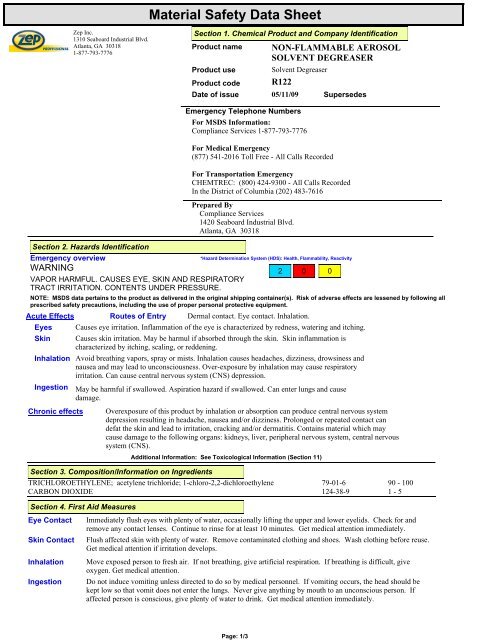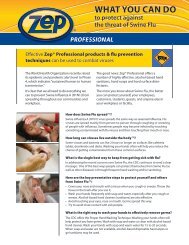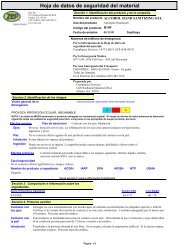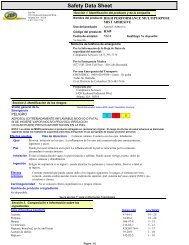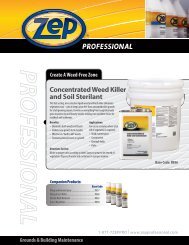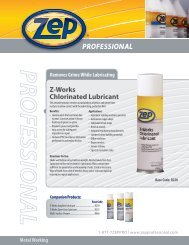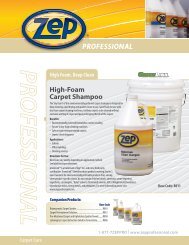MSDS English - Zep Professional
MSDS English - Zep Professional
MSDS English - Zep Professional
Create successful ePaper yourself
Turn your PDF publications into a flip-book with our unique Google optimized e-Paper software.
Material Safety Data Sheet<br />
<strong>Zep</strong> Inc.<br />
1310 Seaboard Industrial Blvd.<br />
Atlanta, GA 30318<br />
1-877-793-7776<br />
Section 1. Chemical Product and Company Identification<br />
Product name NON-FLAMMABLE AEROSOL<br />
SOLVENT DEGREASER<br />
Product use Solvent Degreaser<br />
Product code R122<br />
Date of issue 05/11/09 Supersedes<br />
Emergency Telephone Numbers<br />
For <strong>MSDS</strong> Information:<br />
Compliance Services 1-877-793-7776<br />
For Medical Emergency<br />
(877) 541-2016 Toll Free - All Calls Recorded<br />
For Transportation Emergency<br />
CHEMTREC: (800) 424-9300 - All Calls Recorded<br />
In the District of Columbia (202) 483-7616<br />
Prepared By<br />
Compliance Services<br />
1420 Seaboard Industrial Blvd.<br />
Atlanta, GA 30318<br />
Section 2. Hazards Identification<br />
Emergency overview<br />
*Hazard Determination System (HDS): Health, Flammability, Reactivity<br />
WARNING<br />
VAPOR HARMFUL. CAUSES EYE, SKIN AND RESPIRATORY<br />
TRACT IRRITATION. CONTENTS UNDER PRESSURE.<br />
2 0 0<br />
NOTE: <strong>MSDS</strong> data pertains to the product as delivered in the original shipping container(s). Risk of adverse effects are lessened by following all<br />
prescribed safety precautions, including the use of proper personal protective equipment.<br />
Acute Effects Routes of Entry Dermal contact. Eye contact. Inhalation.<br />
Eyes<br />
Skin<br />
Causes eye irritation. Inflammation of the eye is characterized by redness, watering and itching.<br />
Causes skin irritation. May be harmul if absorbed through the skin. Skin inflammation is<br />
characterized by itching, scaling, or reddening.<br />
Inhalation Avoid breathing vapors, spray or mists. Inhalation causes headaches, dizziness, drowsiness and<br />
nausea and may lead to unconsciousness. Over-exposure by inhalation may cause respiratory<br />
irritation. Can cause central nervous system (CNS) depression.<br />
Ingestion May be harmful if swallowed. Aspiration hazard if swallowed. Can enter lungs and cause<br />
damage.<br />
Chronic effects<br />
Overexposure of this product by inhalation or absorption can produce central nervous system<br />
depression resulting in headache, nausea and/or dizziness. Prolonged or repeated contact can<br />
defat the skin and lead to irritation, cracking and/or dermatitis. Contains material which may<br />
cause damage to the following organs: kidneys, liver, peripheral nervous system, central nervous<br />
system (CNS).<br />
Additional Information: See Toxicological Information (Section 11)<br />
Section 3. Composition/Information on Ingredients<br />
TRICHLOROETHYLENE; acetylene trichloride; 1-chloro-2,2-dichloroethylene 79-01-6 90 - 100<br />
CARBON DIOXIDE 124-38-9 1 - 5<br />
Section 4. First Aid Measures<br />
Eye Contact<br />
Skin Contact<br />
Inhalation<br />
Ingestion<br />
Immediately flush eyes with plenty of water, occasionally lifting the upper and lower eyelids. Check for and<br />
remove any contact lenses. Continue to rinse for at least 10 minutes. Get medical attention immediately.<br />
Flush affected skin with plenty of water. Remove contaminated clothing and shoes. Wash clothing before reuse.<br />
Get medical attention if irritation develops.<br />
Move exposed person to fresh air. If not breathing, give artificial respiration. If breathing is difficult, give<br />
oxygen. Get medical attention.<br />
Do not induce vomiting unless directed to do so by medical personnel. If vomiting occurs, the head should be<br />
kept low so that vomit does not enter the lungs. Never give anything by mouth to an unconscious person. If<br />
affected person is conscious, give plenty of water to drink. Get medical attention immediately.<br />
Page: 1/3
Page: 2/3<br />
Product code R122<br />
Material Safety Data Sheet<br />
Product Name NON-FLAMMABLE AEROSOL<br />
SOLVENT DEGREASER<br />
Section 5. Fire Fighting Measures<br />
Flash Point<br />
Flammable Limits<br />
Flammability<br />
Fire hazard<br />
Fire-Fighting<br />
Procedures<br />
Not available.<br />
Lower: 8%<br />
Upper: 10%<br />
Non-combustible. Vapor may cause flash fire.<br />
National Fire Protection Association (U.S.A.)<br />
2 0 0<br />
CONTENTS UNDER PRESSURE. Do not allow vapor to accumulate in low or confined areas.<br />
In a fire or if heated, a pressure increase will occur and the container may burst.<br />
Use an extinguishing agent suitable for the surrounding fire.<br />
Section 6. Accidental Release Measures<br />
Spill Clean up<br />
Put on appropriate personal protective equipment (see section 8). Stop leak if without risk. Move containers<br />
from spill area. Dilute with water and mop up if water-soluble or absorb with an inert dry material and place in<br />
an appropriate waste disposal container. Dispose of via a licensed waste disposal contractor.<br />
Section 7. Handling and Storage<br />
Handling<br />
Storage<br />
Put on appropriate personal protective equipment (see section 8). Do not allow vapor to accumulate in low or<br />
confined areas. Eating, drinking and smoking should be prohibited in areas where this material is handled, stored and<br />
processed. Do not get in eyes or on skin or clothing. Do not breathe vapor or mist. Use with adequate ventilation.<br />
Do not ingest. Wash thoroughly after handling.<br />
CONTENTS UNDER PRESSURE. Store away from direct sunlight in a dry, cool and well-ventilated area, away from<br />
incompatible materials (see section 10) and food and drink. Do not puncture, incinerate or store the container at<br />
temperatures above 49°C (120°F) or in direct sunlight. Keep out of the reach of children.<br />
Section 8. Exposure Controls/Personal Protection<br />
Product name<br />
TRICHLOROETHYLENE; acetylene trichloride; 1-chloro-2,2-<br />
dichloroethylene<br />
CARBON DIOXIDE<br />
Personal Protective Equipment (PPE)<br />
Eyes<br />
Body<br />
Respiratory<br />
Exposure limits<br />
ACGIH TLV (United States).<br />
TWA: 10 ppm 8 hour(s).<br />
STEL: 25 ppm 15 minute(s).<br />
OSHA PEL (United States).<br />
TWA: 50 ppm 8 hour(s).<br />
STEL: 200 ppm 15 minute(s).<br />
ACGIH TLV (United States).<br />
TWA: 5000 ppm 8 hour(s).<br />
STEL: 30000 ppm 15 minute(s).<br />
Safety glasses.<br />
Wear appropriate protective clothing to prevent skin contact.<br />
Recommended: Viton gloves.<br />
Use with adequate ventilation. Provide exhaust ventilation or other engineering<br />
controls to keep the airborne concentrations of vapors below their respective<br />
occupational exposure limits. Wear appropriate respirator when ventilation is<br />
inadequate.<br />
Section 9. Physical and Chemical Properties<br />
Physical State<br />
pH<br />
Boiling Point<br />
Specific Gravity<br />
Solubility<br />
Liquid. [Aerosol.]<br />
Not available.<br />
87.2°C (189°F)<br />
1.45<br />
Insoluble in the following materials: cold water.<br />
Color Clear. Colorless.<br />
Odor Chlorinated hydrocarbon. [Strong]<br />
Vapor Pressure 8 kPa (60 mm Hg)<br />
Vapor Density 4.5 [Air = 1]<br />
Evaporation Rate 3.1 (Ether (anhydrous). = 1)<br />
VOC (Consumer) 1458 (g/l). (100%)<br />
Section 10. Stability and Reactivity<br />
Stability and Reactivity The product is stable.<br />
Incompatibility<br />
Reactive or incompatible with the following materials: oxidizing materials, metals and alkalis.<br />
Hazardous Polymerization Will not occur.<br />
Hazardous Decomposition Products May emit toxic fumes under fire conditions. carbon oxides (CO, CO2), Phosgene gas. Hydrogen<br />
chloride (HCl).
Product code R122<br />
Material Safety Data Sheet<br />
Product Name NON-FLAMMABLE AEROSOL<br />
SOLVENT DEGREASER<br />
Section 11. Toxicological Information<br />
Acute Toxicity<br />
Product/ingredient name Result Species Dose Exposure<br />
Trichloroethylene LD50 Dermal Rabbit 10000 mg/kg -<br />
LD50 Oral Rat 4920 mg/kg -<br />
LD50 Oral Mouse 2402 mg/kg -<br />
Section 12. Ecological Information<br />
Environmental Effects<br />
Aquatic Ecotoxicity<br />
No known significant effects or critical hazards.<br />
Not available.<br />
Section 13. Disposal Considerations<br />
Waste Information<br />
Waste must be disposed of in accordance with federal, state and local environmental control regulations. Consult your local or<br />
regional authorities for additional information.<br />
Waste Stream<br />
Code: U228 - Unused Product<br />
Classification: - [Hazardous waste.]<br />
Origin: - [RCRA waste.]<br />
Section 14. Transport Information<br />
Regulatory information UN number Proper shipping name Classes PG* Label<br />
DOT Classification<br />
Not available.<br />
Consumer commodity<br />
ORM-D<br />
IMDG Class<br />
Not determined.<br />
NOTE: DOT classification applies to most package sizes. For specific container size classifications or for size exceptions, refer to<br />
the Bill of Lading with your shipment.<br />
PG* : Packing group<br />
Section 15. Regulatory Information<br />
U.S. Federal Regulations<br />
SARA 313 toxic chemical notification and release reporting:<br />
Product name<br />
Trichloroethylene<br />
Clean Water Act (CWA) 307: Trichloroethylene<br />
Clean Water Act (CWA) 311: Trichloroethylene (RQ 100 lbs)<br />
Clean Air Act (CAA) 112 regulated toxic substances: Trichloroethylene<br />
All Components of this product are listed or exempt from listing on TSCA Inventory.<br />
State Regulations<br />
California Prop 65<br />
WARNING: This product contains a chemical or chemicals known to the state<br />
of California to cause cancer, birth defects or other reproductive harm.:<br />
Trichloroethylene<br />
Section 16. Other Information<br />
To the best of our knowledge, the information contained herein is accurate. However, neither the above named supplier nor any of its subsidiaries assumes any<br />
liability whatsoever for the accuracy or completeness of the information contained herein.<br />
Final determination of suitability of any material is the sole responsibility of the user. All materials may present unknown hazards and should be used with caution.<br />
Although certain hazards are described herein, we cannot guarantee that these are the only hazards that exist.<br />
*NOTE: Hazard Determination System (HDS) ratings are based on a 0-4 rating scale, with 0 representing minimal hazards or risks, and 4 representing significant hazards or risks<br />
Although these ratings are not required on <strong>MSDS</strong>s under 29 CFR 1910.1200, the preparer may choose to provide them. HDS ratings are to be used with a fully implemented program to<br />
relay the meanings of this scale.


